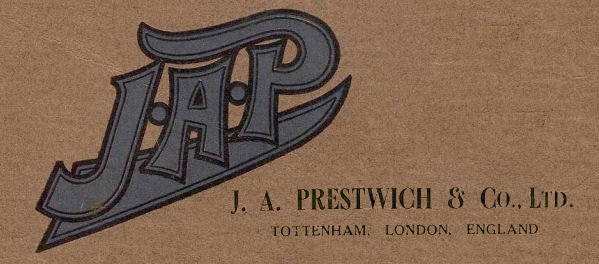

Based in Tottenham, Middlesex.
Designed his first motorcycle engine in 1901, but it was not produced until 1903. Made the first overhead-valve V-twin in 1906. Built a 660cc three-cylinder engine for Dennell. Val Page worked for JAP before going to Ariel. JAP patented a desmodromic valve design in 1923. Very successful after World War I supplying engines for many manufacturers, but as more companies developed their own engines, JAP relied heavily on industrial engine sales in the 1930s. Merged with Villiers in 1957.
They were a British engineering company named for the founder John Alfred Prestwich, which produced cinematographic equipment, internal combustion engines (for which the company was generally abbreviated to J.A.P.), and other examples of precision engineering.
1895 John Alfred Prestwich, an engineer, formed the company in 1895 when he was in his early twenties. Prestwich came to be known as much for his creation of cinematography projectors as his engines. He worked with S.Z. de Ferranti and later the cinema pioneer William Friese-Greene.
1901 Designed and built his first engine.
1903 First complete motorcycle shown at the Stanley Show. It had a BSA frame, sprung forks and a vertically mounted 3.5hp ohv engine. A single push-rod opened both valves, and the cam had track to pull and push as required. There was also a lightweight model fitted with a 2.25hp inclined engine.
1905 Motorcycles continued with a 2.5hp and a 3.5hp, as well as a three-wheeler.
1906 Produced a 3.5hp single, a 6hp V-twin and a forecar having an 8hp three-cylinder in-line engine.
1908 The company stopped motorcycle manufacture in order to concentrate on engines. The engines were used in many famous motorcycle marques and other equipment, such as early aircraft, chainsaws, cultivators such as those produced by Howard Rotovators and light rail maintenance trucks. The motorcycle engines were associated with racing success and were still used in speedway bikes well into the 1960s.
Early aircraft were light and basic, and needed a reliable and lightweight engine to power them and JAP motorcycle engines were ideal. J. A. Prestwich at first would purely deliver the same engine to the aircraft manufacturer, allowing them to make local modifications - mainly larger venturi tubes for the carburettor, to allow for greater air intake at altitude.
In the late 1920s / early 1930s they produced various heavier engines under licence including those for the UK market for Aeronco.
In light of JAP's development of high powered but light engines for speedway, some low volume pre-war car manufacturers, including the Morgan Motor Co and Reliant, used JAP engines to power their vehicles. This use of the JAP extended into motor racing after the Second World War, with most were used in specialist UK lightweight formulas, or more extensively in Formula 3 racing after developments by John Cooper.
After 1945 production was taken over by Villiers
1951 Public company.
1961 Manufacture JAP stationary and motor cycle engines and Masters pencils.
1964 The company was completely absorbed by Villiers, just as Villiers itself was to be taken over by Manganese Bronze. In its later life, J. A. Prestwich also produced components for other vehicle manufacturers, including the cylinder head for the Lotus Cortina version of Ford's popular car of the 1960s. This was one of their last products.
Cinematographic equipment including cameras, printers, mutoscopes, cutting and perforating machines, and projectors (eg the Bioscope projectors for the Warwick Trading Co and Charles Urban) were produced by the company in the early part of the 20th century.
The extensive list of manufacturers which employed JAP engines includes:
If you have further information or a query related to this page, please contact us